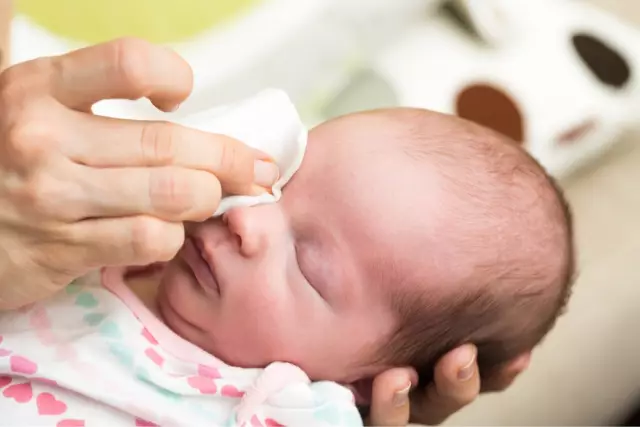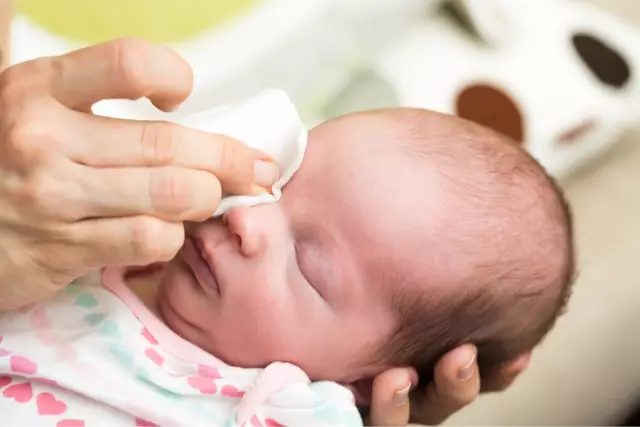- Author Curtis Blomfield [email protected].
- Public 2023-12-16 20:44.
- Last modified 2025-01-23 17:01.
Ophthalmologists know that this serious disease is quite common among adult patients and children. Purulent conjunctivitis should be treated by an experienced specialist, so self-medication, advice from “knowledgeable” neighbors and girlfriends in this case are unacceptable. The disease can be of several varieties, and therefore the effectiveness of treatment directly depends on the correct diagnosis.
Purulent conjunctivitis is a lesion of the mucous membrane of the eye, which is caused by pathogenic bacteria. The main symptom of this disease is the release of exudate (purulent contents) from the affected eyes. In addition, the patient, as a rule, feels a strong burning sensation and irritation of the eyeball. It should be said that with timely access to a specialist, treatment is carried out quite quickly and efficiently, but on the condition that the patient will strictly follow the doctor's recommendations.

Causes of disease
Microbes that have fallen on the mucous membrane of the eye are the main cause of the development of the disease. It quite often develops when the eyes are rubbed with hands, when specks get on the mucous membrane, which were previously infected with bacteria. More often, the infection affects both eyes at the same time, but it happens that the difference in the time of manifestation of clinical signs can be 2-3 days.
As a rule, the treatment of purulent eye conjunctivitis in adults (and children) depends on what caused the disease:
- gram-negative rods - Proteus, Klebsiella, diphtheria, Pseudomonas aeruginosa, Escherichia coli;
- coccal flora - streptococcus, staphylococcus, gonococcus.
The development and treatment of purulent conjunctivitis in adults can be complicated by the presence of increased activity in the body of chlamydia, as well as gonorrhea pathogens. In this case, not only contact with an infected person is sufficient, but also the use of his hygiene items, on which pathogenic microflora is preserved.
Symptoms of the disease can appear two to three days after suffering a sore throat caused by streptococcus, scarlet fever and other infectious diseases. As a rule, infection occurs through contact from an infected person or animal. Unfortunately, pets also carry the infection.
A large (and in some cases decisive) role in the development of the disease is played by reduced immunity. In case of violation of sanitary standards, an infection can also develop in the hospital, which is quite resistant to mostantiseptics.

Allergic conjunctivitis
It is impossible not to say about the existence of allergic purulent conjunctivitis of the eyes. Its treatment has its own characteristics, which is associated with slightly different manifestations of the disease. Usually this is a strong irritation of the eyeballs and eyelids, which is manifested by their redness, itching. Purulent discharge is either absent or present in small amounts. House dust, plant pollen, food, animal hair, chemical irritants - all this can provoke the development of purulent conjunctivitis. Treatment in this case is primarily aimed at limiting the patient's contact with the allergen. In addition, the use of antihistamines and antiallergic drops (Olopatadin, Cromohexal, Dexamethasone, Allergodil) is recommended.
Classification
Depending on the microorganism that caused the disease, purulent conjunctivitis is divided into:
- gonococcal;
- streptococcal or staphylococcal;
- pyocyanic.
Gonococcal conjunctivitis
This is a rather rare form of the disease. It develops in a newborn on the second day after birth. The cause of the disease is infection of the mother with gonorrhea. This form is rare because pregnant women are usually examined and treated long before delivery. It usually occurs in asocial families, where a woman is not registered in the antenatal clinic, is not observed during gestation.

The danger of this type of disease lies in the damage to the cornea. Untreated purulent conjunctivitis in newborns and adults can lead to complete blindness. After the treatment, scars remain on the conjunctiva.
Staphylococcal (streptococcal) conjunctivitis
Infection occurs through contact with an infected person during a handshake, the use of common personal hygiene products. The disease develops rapidly. Its acute period lasts approximately 12 days. In the absence of competent treatment, the disease becomes chronic: the exudate becomes serous and rather scarce. The symptoms of the disease are somewhat erased, it is more difficult to treat.
Pseudomonas aeruginosa
This disease can develop as a result of microtrauma, with improper use of contact lenses, it is also caused by dust in the eyes. Most often, this disease develops in one eye, rarely capturing the other eye. This type of disease is characterized by the rapid development of clinical signs. Initially, lacrimation, photophobia are noted. After a day or two, purulent discharge appears. This leads to the formation of corneal erosions (superficial), through which the infection rushes deep into. The disease can be complicated by keratitis - inflammation of the cornea. In place of ulcers and erosions, scars form, which subsequently reduce visual acuity.
Symptoms of purulent conjunctivitis
The main signs of the disease include:
- eyelid swelling;
- photophobia;
- itching, burning, foreign body sensation;
- hyperemia of the conjunctiva and eyelids;
- lacrimation;
- mucopurulent yellowish discharge that sticks together eyelashes and can make it difficult to open the eyes;
- weakness, fever (especially common in children), malaise.
Depending on the type of microorganism that caused the disease, the severity of symptoms depends. In some cases, not all signs appear, but only some of them. For example, exudate may not appear at all or be released in large quantities: a person cannot open his eyes in the morning until he removes purulent discharge with the help of medications. Most often, the disease affects both eyes with a time difference of several hours to two days.

Which specialist should I contact if I have symptoms of illness?
Treatment of purulent conjunctivitis of the eyes in children and adults is carried out by an ophthalmologist. If for some reason there is no such specialist in your clinic, adult patients should consult a general practitioner, and show the child to a pediatrician.
Diagnosis
An accurate diagnosis can only be made by a doctor based on a visual examination, identifying the main symptoms of the disease. Additional laboratory testing of eye discharge will be required to identify the pathogen and determine its sensitivity to antibiotics.
Purulent conjunctivitis: treatment
We have already said, but we will repeat once again that the treatment of the disease must be started immediately after the establishmentdiagnosis, so that it does not turn into a chronic form with irreversible complications. As a rule, an experienced ophthalmologist selects local treatment for the treatment of purulent conjunctivitis. Only in severe, advanced forms of infection with complications in the form of keratitis, antibiotic therapy is prescribed.
Several times a day, the eyes are washed with antibacterial solutions ("Rivanol", "Levomycetin"), antiseptics (a pale pink solution of potassium permanganate). In the treatment of purulent conjunctivitis in children and adults, antibacterial drops (Tsiprolet, Tobrex, Tsipromed, Okomistin, Floksal) should be instilled during the day.

In complex treatment, you can also use folk remedies (in agreement with the attending physician), namely, washing the eyes with decoctions of medicinal herbs: sage, chamomile, St. John's wort, yarrow, coltsfoot, freshly brewed tea. Eye ointments based on antibiotics (“Erythromycin”, “Floxal”, “Tetracycline”) are applied over the eyelids before going to bed. The duration of treatment for purulent conjunctivitis of the eyes in adults and children is determined by the doctor. With self-cancellation of therapy, a relapse of the disease, the appearance of complications is quite likely.
Treatment regimen (for adults)
Treatment of purulent conjunctivitis should be phased. Immediately after sleep, the eyes are washed from purulent crusts. To do this, moisten a cotton ball or disc with a weak solution of manganese and wipe the eyelids and eyelashes. Then, using a syringe without a needle, the conjunctival sacs are washed out. This should definitely be done in the morning, but withIf necessary, this procedure is repeated several times during the day.
Treatment continues with antibacterial eye drops. The doctor selects them taking into account the sensitivity to their composition of the microflora that caused the disease. The therapeutic effect will be achieved if one drop is dropped into each eye, since only a drop fits into the conjunctival sac of both an adult and a child. The rest of the medicine will just flow out. During the period of exacerbation of the disease, the eyes are instilled every hour. This will achieve the maximum therapeutic effect. The fact is that profuse lacrimation washes the medicinal substance out of the eye, preventing it from acting on the infection. Do not be afraid of drug overdose. Eye drops are usually only topical.
When purulent discharge increases, the eyes are washed again. At night, an antibiotic ointment is applied over the eyelids. When the acute manifestations of the disease are reduced, the frequency of instillations is reduced to 6 times a day. Treatment continues until the complete disappearance of signs of the disease and another 3-5 days. This is necessary to prevent the transition of the disease from acute to chronic.

Conjunctivitis in children
Unfortunately, this disease is much more common in children than in adults. The well-known pediatrician E. O. Komarovsky often talks about this in his programs. Treatment of purulent conjunctivitis in children, in his opinion, rejects any self-treatment, especially if the disease is detected in a newborn or a child under one year old.
Baby urgently neededshow the doctor even if the treatment does not improve the condition of the baby's eyes within two days. In addition, it is necessary to call a doctor at home with photophobia, even if (in the opinion of the parents) the redness of the eyeball seems insignificant. With such a symptom, the child squints, squints from bright light, can rub his eyes. If a child is concerned about a decrease in the clarity of vision, cutting pain in the eyes, it is urgent to call a doctor, Komarovsky believes. The appearance of watery bubbles on the upper eyelid will also require urgent help.
The causes of this disease in children are the same: infections and bacteria get into the eyes. If there are animals in the house, then it is they who can become carriers of the disease, and if adult family members with stronger immunity may not adopt the disease, then purulent conjunctivitis will manifest itself in babies several times during the year.
Child treatment
Awakening baby in the morning, clean the eyes with a cotton swab dipped in a weak solution of potassium permanganate, and a separate swab is required for each eye. Gently open the eyelid and moisten with the same solution, shifting the exudate to the inner corner, the conjunctiva. Some parents find it easier to do this with a bulb or syringe without a needle.
For the treatment of purulent conjunctivitis in children, drops are required. In each eye, gently sliding the lower eyelid, add a drop of Levomycetin. Even if at the moment only one eye is affected, the second one must be treated without fail. This procedure is repeated every hour and a half. With rareinstillation (up to five times a day), microbes get used to the antibiotic contained in the drops, which is fraught with the transition of the disease to a chronic form.

If the separation of pus continues, treatment with a light pink solution of potassium permanganate must be repeated 2-3 more times. Before going to bed, the baby is placed in the conjunctival sacs with Tetracycline ointment (as prescribed by the doctor).
Prevention
To prevent the development of this serious disease, it is necessary to strictly observe the rules of hygiene:
- do not use other people's hygiene items;
- don't rub your eyes;
- wipe them only with sterile disposable handkerchiefs;
- use and handle contact lenses properly;
- when the sun is bright, wear sunglasses.
In maternity hospitals, special preventive measures are taken to prevent conjunctivitis in newborns.






